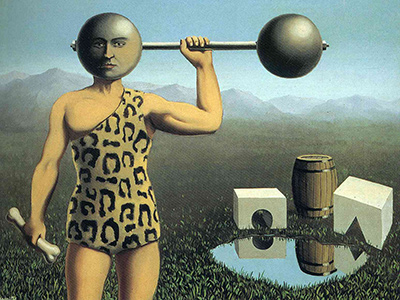Perpetual Motion
Perpetual Motion is undoubtedly one of Rene Magritte’s most extravagantly strange and inventive surrealist paintings.
Many of Magritte’s paintings employ visual humour, but the jests are often quite discreet. In contrast, Perpetual Motion demonstrates a somewhat slapstick sense of humour.
The strong, masculine figure in the foreground of the painting resembles both a circus strong-man and a primitive caveman.
In one hand, he holds a club-like bone; in the other, he hoists a cartoonish set of weights. Amusingly, One of the weights features a human face and is positioned so that it can serve as his head.
Interestingly, Perpetual Motion isn’t the first Magritte painting to employ this visual joke. Many of his paintings show human bodies merging with or being replaced by inanimate objects.
For example, in 1927, he painted Discovery, which shows a woman whose body is slowly metamorphosing into wood. In The Son of Man, he obscured his subject’s face with a floating apple, effectively replacing the figure’s features with the fruit.
While Magritte could make images like these disturbing, he clearly prefers to deploy them humorously. He uses the technique of replacing and merging people with objects to play with the concept of identity, yet he never deprives his figures of a sense of identity or personality.
Perpetual Motion was painted using oils in 1935, after Magritte fully embraced surrealism. However it may owe its existence to the dadaist artistic philosophy that he dabbled with in the 1920s. Dadaism emerged after the First World War and its proponents blamed reason and rationality for the conflict.
They believed that capitalist society’s focus on logic had led to an unfeeling attitude that created the conditions necessary for conflict. It’s worth noting that Perpetual Motion’s imagery seems to mock the idea of strength (which could be interpreted as a dadaist attack on the idea of military strength).
The weight-lifting figure is depicted as primitive and his weights (the symbol of his strength) have replaced his head. This may suggest that his ability to think like a human being has been consumed or replaced by the obsession with strength.
Regardless of the painting’s meaning, it is clearly a fine example of surreal imagery and highly-developed symbolism. It also shows Magritte’s artistic influences, making it fascinating for anyone with an interest in his life or career.





